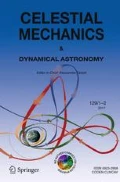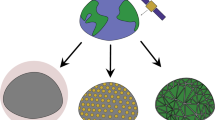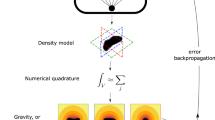Abstract
The physics-informed neural network (PINN) gravity model offers a novel and efficient way to represent high-fidelity gravity fields. PINNs leverage modern deep learning strategies to generate custom basis functions capable of modeling idiosyncratic features of a celestial body’s gravity field, bypassing the inefficiencies encumbered by gravity models which prescribe geometries like spherical harmonics. Prior research on the PINN gravity model focuses on its ability to represent the gravity fields of large, near-spherical celestial bodies with highly discontinuous surface features. This research extends the investigation of the PINN gravity model to the small-body regime. Specifically, the results demonstrate that the PINN gravity model is capable of solving the additional challenges associated with modeling small-body gravity fields such as divergence within the Brillouin sphere, cumbersome computational requirements, and sample-inefficient regression. Further, this paper investigates strategies to improve network gravity modeling performance—demonstrating how additional physics constraints in network cost function can increase robustness to noise in the training data and how introducing transformer-inspired changes to the network architecture can offer order-of-magnitude improvements in modeling accuracy.














Similar content being viewed by others
Data availability
The datasets generated during and/or analyzed during the current study are available from the corresponding author on reasonable request.
References
Baydin, A.G., Pearlmutter, B.A., Siskind, J.M.: Automatic differentiation in machine learning: a survey. J. Mach. Learn. Res. 18, 1–43 (2018)
Chesley, S.R., et al.: Trajectory estimation for particles observed in the vicinity of 101955 Bennu. J. Geophys. Res. Planets (2010). https://doi.org/10.1029/2019JE006363
Han, S.-C., Jekeli, C., Shum, C.K.: Efficient gravity field recovery using in situ disturbing potential observables from CHAMP. Geophys. Res. Lett. 29(16), 1–4 (2002). https://doi.org/10.1029/2002gl015180
Jayalakshmi, T., Santhakumaran, A.: Statistical normalization and back Propagationfor classification. Int. J. Comput. Theory Eng. 3(1), 89–93 (2011). https://doi.org/10.7763/ijcte.2011.v3.288
Jekeli, C.: Potential theory and the static gravity field of the earth. In: Treatise on Geophysics: Second Edition 3, pp. 9–35. issn: 9780444538031. (2015) https://doi.org/10.1016/B978-0-444-53802-4.00056-7.
Kaula, W.M.: Theory of Satellite Geodesy: Applications of Satellites to Geodesy. Blaisdell Publishing Co, Waltham, Mass. (1966)
Kawaguchi, J., Fujiwara, A., Uesugi, T.: Hayabusa-its technology and science accomplishment summary and Hayabusa-2. Acta Astron. 62(10–11), 639–647 (2007). https://doi.org/10.1016/j.actaastro.2008.01.028
Lauretta, D.S., et al.: OSIRIS-REx: sample return from asteroid (101955) Bennu. Space Sci. Rev. 212(1–2), 925–984 (2017). https://doi.org/10.1007/s11214-017-0405-1
Lemoine, F.G., et al.: GRGM900C: a degree 900 lunar gravity model from GRAIL primary and extended mission data. Geophys. Res. Lett. 41(10), 3382–3389 (2014). https://doi.org/10.1002/2014GL060027
Leonard, J.M., Geeraert, J.L., et al.: Osiris-Rex orbit determination performance during the Navigation Campaign. Adv. Astron. Sci. 171, 3031–3050 (2020)
Leonard, J.M., Nievinski, F.G., Born, G.H.: Gravity error compensation using second-order gauss-markov processes. J. Spacecr. Rockets 50(1), 217–229 (2013). https://doi.org/10.2514/1.A32262
Martin, J., Schaub, H.: Physics-informed neural networks for gravity field modeling of the Earth and Moon. Celest. Mech. Dyn. Astron. (2022). https://doi.org/10.1007/s10569-022-10069-5
McMahon, J.W., Scheeres, D.J., Hesar, S.G., et al.: The OSIRIS-REx Radio science experiment at Bennu. Space Sci. Rev. (2018). https://doi.org/10.1007/s11214-018-0480-y
McMahon, J.W., Scheeres, D.J., Chesley, S.R., et al.: Dynamical evolution of simulated particles ejected from Asteroid Bennu. J. Geophys. Res. Planets 125(8), 1–18 (2020). https://doi.org/10.1029/2019JE006229
Miller, J.K., et al.: Determination of shape, gravity, and rotational state of asteroid 433 Eros. Icarus 155(1), 3–17 (2002). https://doi.org/10.1006/icar.2001
Oh, D. Y. et al.: psyche: journey to a MetalWorld. In: 52nd AIAA/SAE/ASEE Joint Propulsion Conference, 2016 2014, pp. 1–11. issn: 9781624104060. (2016) https://doi.org/10.2514/6.2016-4541.
Park, R.S., Werner, R.A., Bhaskaran, S.: Estimating small-body gravity field from shape model and navigation data. J. Guid. Control Dyn. 33(1), 212–221 (2010). https://doi.org/10.2514/1.41585
Pines, S.: Uniform representation of the gravitational potential and its derivatives. AIAA J. 11(11), 1508–1511 (1973). https://doi.org/10.2514/3.50619
Raissi, M., Perdikaris, P., Karniadakis, G.: Physics-Informed Neural Networks: a deep learning framework for solving forward and inverse problems Involving nonlinear partial differential equations. J. Comput. Phys. 378, 686–707 (2019). https://doi.org/10.1016/j.jcp.2018.10.045
Russell, C.T., et al.: Dawn Mission to Vesta and Ceres. Earth Moon Planets 101(1–2), 65–91 (2007). https://doi.org/10.1007/s11038-007-9151-9
Takahashi, Y., Scheeres, D.J.: Small body surface gravity fields via spherical harmonic expansions. Celest. Mech. Dyn. Astron. 119(2), 169–206 (2014). https://doi.org/10.1007/s10569-014-9552-9
Takahashi, Y., Scheeres, D.J., Werner, R.A.: Surface gravity fields for asteroids and comets. J. Guid. Control Dyn. 36(2), 362–374 (2013). https://doi.org/10.2514/1.59144
Takahashi, Y., Scheeres, D.: Morphology driven density distribution estimation for small bodies. Icarus 233, 179–193 (2014). https://doi.org/10.1016/j.icarus.2014.02.004
Tapley, B.D.: Gravity model determination from the GRACE Mission. J. Astron. Sci. 56(3), 273–285 (2008). https://doi.org/10.1007/BF03256553
Tardivel, S.: The Limits of the Mascons Approximation of the Homogeneous Polyhedron. In: AIAA/AAS Astrodynamics Specialist Conference. September. Reston, Virginia: American Institute of Aeronautics and Astronau- tics, pp. 1–13. isbn: 978-1-62410-445-9, (2016) https://doi.org/10.2514/6.2016-5261.
Villa, J. et al.: Gravity estimation of small bodies via optical tracking of hopping artificial probes. In: AAS/AIAA Astrodynamics Specialist Conference. Big Sky, Montana, pp. 1–21. (2021)
Wang, S., Teng, Y., Perdikaris, P.: Understanding and mitigating gradient pathologies in physics-informed neural networks. In: arXiv, pp. 1– 28. (2020)
Watanabe, S., et al.: Hayabusa2 mission overview. Space Sci. Rev. 208(1–4), 3–16 (2017). https://doi.org/10.1007/s11214-017-0377-1
Werner, R., Scheeres, D.: Exterior gravitation of a polyhedron derived and compared with harmonic and mascon gravitation representations of Asteroid 4769 castalia. Celest. Mech. Dyn. Astron. 65(3), 313–344 (1997). https://doi.org/10.1007/BF00053511
Wittick, P.T., Russell, R.P.: Mascon models for small body gravity fields. Adv. Astron. Sci. 162, 2003–2020 (2018)
Wittick, P.T., Russell, R.P.: Mixed-model gravity representations for small celestial bodies using mascons and spherical harmonics. Celest. Mech. Dyn. Astron. 131(7), 31–317 (2019). https://doi.org/10.1007/s10569-019-9904-6
Xu, P.: The value of minimum norm estimation of geopotential fields. Geophys. J. Int. 111(1), 170–178 (1992). https://doi.org/10.1111/j.1365-246X.1992.tb00563.x
Xu, P.: Truncated SVD methods for discrete linear Ill-Posed Prob- lems. Geophys. J. Int. 135(2), 505–514 (1998). https://doi.org/10.1046/j.1365-246X.1998.00652.x
Xu, P., Fukuda, Y., Liu, Y.: Multiple parameter regularization: numerical solutions and applications to the determination of geopotential from precise satellite orbits. J. Geodesy 80(1), 17–27 (2006). https://doi.org/10.1007/s00190-006-0025-0
Xu, P., Rummel, R.: Generalized ridge regression with applications in determination of geopotential fields. Manuscr. Geoda pp. 8– 20 (1994) issn: 0340-8825
Acknowledgements
This material is based upon work supported by the National Science Foundation Graduate Research Fellowship under Grant No. 2040434.
Author information
Authors and Affiliations
Corresponding author
Additional information
Publisher's Note
Springer Nature remains neutral with regard to jurisdictional claims in published maps and institutional affiliations.
This article is part of the topical collection on Machine Learning in Celestial Mechanics and Dynamical Astronomy. Guest Editors: Massimiliano Vasile, Xiyun Hou, Roberto Furfaro and Alessandra Celletti.
Guest Editors: Xiyun Hou, Massimiliano Vasile and Alessandra Celletti.
This article is part of the topical collection on Dynamics of Space Debris and NEO.
Rights and permissions
Springer Nature or its licensor holds exclusive rights to this article under a publishing agreement with the author(s) or other rightsholder(s); author self-archiving of the accepted manuscript version of this article is solely governed by the terms of such publishing agreement and applicable law.
About this article
Cite this article
Martin, J., Schaub, H. Physics-informed neural networks for gravity field modeling of small bodies. Celest Mech Dyn Astron 134, 46 (2022). https://doi.org/10.1007/s10569-022-10101-8
Received:
Revised:
Accepted:
Published:
DOI: https://doi.org/10.1007/s10569-022-10101-8




